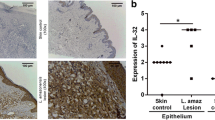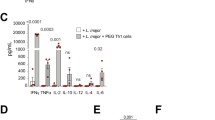Abstract
TNF-negative C57BL/6 (B6.TNF−/−) mice are highly susceptible to Leishmania (L.) major infection and succumb rapidly to fatal leishmaniasis. A T helper type 1 (Th1) cell-mediated immune response is central for protective anti-leishmanial immunity. Therefore, the observed susceptibility of B6.TNF−/− mice to L. major parasites could be caused by a deficiency in mounting a Th1 response. Analysis of infected footpads revealed, that B6.TNF−/− mice exhibited a substantially diminished formation of DCs at the site of infection. Furthermore, Th1 cytokines such as IFN-γ were reduced in footpads of infected B6.TNF−/− mice. Cutaneous reconstitution of B6.TNF−/− mice with either bone marrow derived DCs (BM-DCs) or recombinant TNF simultaneous to infection resulted in an increased expression of cytokines such as IFN-γ and in an enhanced presence of Leishmania-antigen in skin draining lymph nodes. In addition, the individual time of survival was doubled. In conclusion we demonstrate that the expression of dermal TNF is necessary to provide an environment that initiates a local inflammatory response, but is not sufficient to induce protective immunity.




Similar content being viewed by others
Abbreviations
- B6.WT:
-
C57BL/6
- B6.TNF−/− :
-
C57BL/6-TNF−/−
- LN:
-
Lymph node
- L:
-
Leishmania
- DC(s):
-
Dendritic cell(s)
- LC(s):
-
Langerhans cell(s)
- BM-DC:
-
Bone marrow (BM)-derived DC
- SLC/CCL21:
-
Secondary lymphoid-tissue chemokine, or CCL21
- ELC/CCL19:
-
Epstein-Barr virus-induced molecule 1 ligand chemokine, or CCL19
- HEVs:
-
High endothelial venules; s.c., subcutaneously
References
Banchereau J, Briere F, Caux C, Davoust J, Lebecque S, Liu YJ, Pulendran B, Palucka K (2000) Immunobiology of dendritic cells. Annu Rev Immunol 18:767–811
Kelsall BL, Biron CA, Sharma O, Kaye PM (2002) Dendritic cells at the host-pathogen interface. Nat Immunol 3:699–702
Serbina NV, Salazar-Mather TP, Biron CA, Kuziel WA, Pamer EG (2003) TNF/iNOS-producing dendritic cells mediate innate immune defense against bacterial infection. Immunity 19:59–70
Martin-Fontecha A, Sebastiani S, Hopken UE, Uguccioni M, Lipp M, Lanzavecchia A, Sallusto F (2003) Regulation of dendritic cell migration to the draining lymph node: impact on T lymphocyte traffic and priming. J Exp Med 198:615–621
Ritter U, Mattner J, Rocha JS, Bogdan C, Korner H (2004) The control of Leishmania (Leishmania) major by TNF in vivo is dependent on the parasite strain. Microbes Infect 6:559–565
Ritter U, Meissner A, Ott J, Korner H (2003) Analysis of the maturation process of dendritic cells deficient for TNF and lymphotoxin-alpha reveals an essential role for TNF. J Leukoc Biol 74:216–222
Ohl L, Mohaupt M, Czeloth N, Hintzen G, Kiafard Z, Zwirner J, Blankenstein T, Henning G, Forster R (2004) CCR7 governs skin dendritic cell migration under inflammatory and steady-state conditions. Immunity 21:279–288
Sacks D, Noben-Trauth N (2002) The immunology of susceptibility and resistance to Leishmania major in mice. Nat Rev Immunol 2:845–858
Solbach W, Laskay T (2000) The host response to Leishmania infection. Adv Immunol 74:275–317
Diefenbach A, Schindler H, Donhauser N, Lorenz E, Laskay T, MacMicking J, Röllinghoff M, Gresser I, Bogdan C (1998) Type 1 interferon (IFN-α/β) and type 2 nitric oxide synthase regulate the innate immune response to a protozoan parasite. Immunity 8:77–87
Scharton-Kersten T, Afonso LC, Wysocka M, Trinchieri G, Scott P (1995) IL-12 is required for natural killer cell activation and subsequent T helper 1 cell development in experimental leishmaniasis. J Immunol 154:5320–5330
Malherbe L, Filippi C, Julia V, Foucras G, Moro M, Appel H, Wucherpfennig K, Guery JC, Glaichenhaus N (2000) Selective activation and expansion of high-affinity CD4+ T cells in resistant mice upon infection with Leishmania major. Immunity 13:771–782
Himmelrich H, Launois P, Maillard I, Biedermann T, Tacchini-Cottier F, Locksley RM, Rocken M, Louis JA (2000) In BALB/c mice, IL-4 production during the initial phase of infection with Leishmania major is necessary and sufficient to instruct Th2 cell development resulting in progressive disease. J Immunol 164:4819–4825
Wilhelm P, Ritter U, Labbow S, Donhauser N, Rollinghoff M, Bogdan C, Korner H (2001) Rapidly fatal leishmaniasis in resistant C57BL/6 mice lacking TNF. J Immunol 166:4012–4019
Leon B, Lopez-Bravo M, Ardavin C (2007) Monocyte-derived dendritic cells formed at the infection site control the induction of protective T Helper 1 responses against Leishmania. Immunity 26:519–531
Körner H, Cook M, Riminton DS, Lemckert FA, Hoek R, Ledermann B, Köntgen F, Fazekas de St Groth B, Sedgwick JD (1997) Distinct roles for lymphotoxin-α and tumour necrosis factor in lymphoid tissue organogenesis and spatial organisation defined in gene targeted C57BL/6 Mice. Eur J Immunol 27:2600–2609
Wilhelm P, Riminton DS, Ritter U, Lemckert FA, Scheidig C, Hoek R, Sedgwick JD, Korner H (2002) Membrane lymphotoxin contributes to anti-leishmanial immunity by controlling structural integrity of lymphoid organs. Eur J Immunol 32:1993–2003
Solbach W, Forberg K, Kammerer E, Bogdan C, Röllinghoff M (1986) Suppressive effect of cyclosporin A on the development of Leishmania tropica-induced lesions in genetically susceptible BALB/c mice. J Immunol 137:702–711
Wilhelm P, Ritter U, Labbow S, Donhauser N, Röllinghoff M, Bogdan C, Körner H (2001) Rapidly fatal Leishmaniasis in resistant C57BL/6 mice lacking TNF. J Immunol 166:4012–4019
Ritter U, Mattner J, Rocha JS, Bogdan C, Körner H (2004) The control of Leishmania (Leishmania) major by TNF in vivo is dependent on the parasite strain. Microbes Infect 6:559–565
Higuchi R, Fockler C, Dollinger G, Watson R (1993) Kinetic PCR analysis: real-time monitoring of DNA amplification reactions. Biotechnology (N Y) 11:1026–1030
Ponchel F, Toomes C, Bransfield K, Leong FT, Douglas SH, Field SL, Bell SM, Combaret V, Puisieux A, Mighell AJ, Robinson PA, Inglehearn CF, Isaacs JD, Markham AF (2003) Real-time PCR based on SYBR-Green I fluorescence: an alternative to the TaqMan assay for a relative quantification of gene rearrangements, gene amplifications and micro gene deletions. BMC Biotechnol 3:18
Lutz MB, Kukutsch N, Ogilvie AL, Rossner S, Koch F, Romani N, Schuler G (1999) An advanced culture method for generating large quantities of highly pure dendritic cells from mouse bone marrow. J Immunol Methods 223:77–92
Anderson CF, Oukka M, Kuchroo VJ, Sacks D (2007) CD4(+)CD25(-)Foxp3(-) Th1 cells are the source of IL-10-mediated immune suppression in chronic cutaneous leishmaniasis. J Exp Med 204:285–297
Jankovic D, Kullberg MC, Feng CG, Goldszmid RS, Collazo CM, Wilson M, Wynn TA, Kamanaka M, Flavell RA, Sher A (2007) Conventional T-bet(+)Foxp3(-) Th1 cells are the major source of host-protective regulatory IL-10 during intracellular protozoan infection. J Exp Med 204:273–283
Misslitz AC, Bonhagen K, Harbecke D, Lippuner C, Kamradt T, Aebischer T (2004) Two waves of antigen-containing dendritic cells in vivo in experimental Leishmania major infection. Eur J Immunol 34:715–725
Bazzoni F, Beutler B (1996) The tumour necrosis factor ligand and receptor families. N Engl J Med 334:1717–1725
Neumann B, Machleidt T, Lifka A, Pfeffer K, Vestweber D, Mak TW, Holzmann B, Krönke M (1996) Crucial Role of 55-kilodalton TNF receptor in TNF-induced adhesion molecule expression and leukocyte organ infiltration. J Immunol 156:1587–1593
Ngo VN, Körner H, Gunn MD, Schmidt KN, Riminton DS, Cooper MD, Browning JL, Sedgwick JD, Cyster JG (1999) Lymphotoxin alpha/beta and tumor necrosis factor are required for stromal cell expression of homing chemokines in B and T cell areas of the spleen. J Exp Med 189:403–412
Janatpour MJ, Hudak S, Sathe M, Sedgwick JD, McEvoy LM (2001) Tumor necrosis factor-dependent segmental control of MIG expression by high endothelial venules in inflamed lymph nodes regulates monocyte recruitment. J Exp Med 194:1375–1384
von Stebut E, Metz M, Milon G, Knop J, Maurer M (2003) Early macrophage influx to sites of cutaneous granuloma formation is dependent on MIP-1alpha /beta released from neutrophils recruited by mast cell-derived TNFalpha. Blood 101:210–215
Steinman RM, Pack M, Inaba K (1997) Dendritic cells in the T-cell areas of lymphoid organs. Immunol Rev 156:25–37
Ritter U, Korner H (2002) Divergent expression of inflammatory dermal chemokines in cutaneous leishmaniasis. Parasite Immunol 24:295–301
Ritter U, and Osterloh A (2006) A new view on cutaneous dendritic cell subsets in experimental leishmaniasis. Med Microbiol Immunol (Berl)
Acknowledgements
This work was supported by grants of the James Cook University (MRG and CRIG to HK), and by the Federal Ministry of Education and Research (BMBF) and the Interdisciplinary Center for Clinical Research (IZKF) at the University Hospital of the University of Erlangen-Nürnberg, Germany (HK, IZKF Nachwuchsgruppe 1).
Author information
Authors and Affiliations
Corresponding authors
Rights and permissions
About this article
Cite this article
Ritter, U., Lechner, A., Scharl, K. et al. TNF controls the infiltration of dendritic cells into the site of Leishmania major infection. Med Microbiol Immunol 197, 29–37 (2008). https://doi.org/10.1007/s00430-007-0056-z
Received:
Published:
Issue Date:
DOI: https://doi.org/10.1007/s00430-007-0056-z




